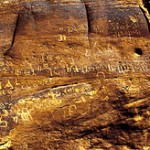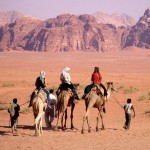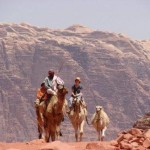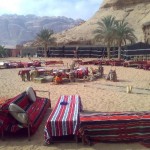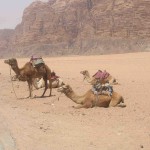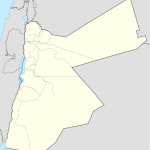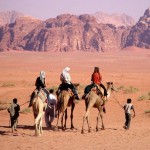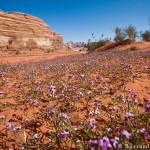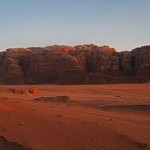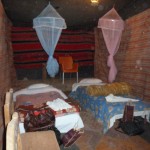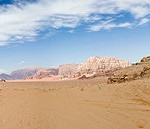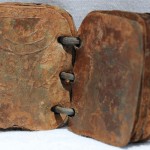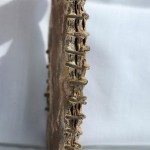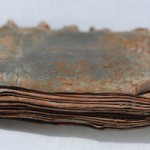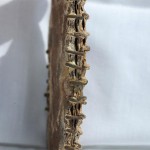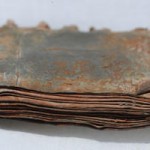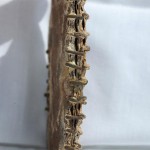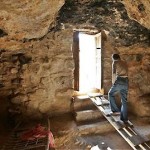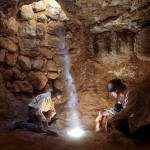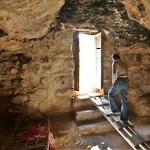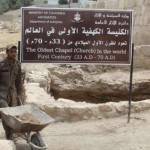Wadi Rum-The Valley of the Moon-Jordan

Wadi Rum is near Petra the Rose City Petra is a fascinating ancient city and was selected as one of the New Seven Wonders of the World. The rose-red city carved into the limestone mountains was predominantly …featured in the climax of the Harrison Ford/Sean Connery movie, Indiana Jones and the Lost Crusade.
Wadi Rum also known as The Valley of the Moon is a valley cut into the sandstone and  granite rock in south Jordan at 60 km to the east of Aqaba. It is the largest wadi in Jordan. The name Rum most likely comes from an Aramaic root meaning ‘high’ or ‘elevated’. To reflect its proper Arabic pronunciation, archaeologists transcribe it as Wadi Ramm. The highest elevation in Wadi Rum is Mount Um Dami at more than 1800m above sea level.
granite rock in south Jordan at 60 km to the east of Aqaba. It is the largest wadi in Jordan. The name Rum most likely comes from an Aramaic root meaning ‘high’ or ‘elevated’. To reflect its proper Arabic pronunciation, archaeologists transcribe it as Wadi Ramm. The highest elevation in Wadi Rum is Mount Um Dami at more than 1800m above sea level.
History
Mount Rum in Wadi Rum stands at 1734 m above sea level. The mountain was named the Seven Pillars of Wisdom (for its shape as seven pillars) by Lawrence of Arabia.
Wadi Rum has been inhabited by many human cultures since prehistoric times, with many cultures–including the Nabateans–leaving their mark in the form of rock paintings, graffiti, and temples. As of 2007, several Bedouin tribes inhabit Rum and the surrounding area.
In the West, Wadi Rum may be best known for its connection with British officer T. E.  Lawrence, who based his operations here during the Arab Revolt of 1917–18. In the 1980s one of the impressive rock formations in Wadi Rum was named “The Seven Pillars of Wisdom” in memory of Lawrence’s book penned in the aftermath of the war, though the ‘Seven Pillars’ referred to in the book actually have no connection with Rum
Lawrence, who based his operations here during the Arab Revolt of 1917–18. In the 1980s one of the impressive rock formations in Wadi Rum was named “The Seven Pillars of Wisdom” in memory of Lawrence’s book penned in the aftermath of the war, though the ‘Seven Pillars’ referred to in the book actually have no connection with Rum
The area was “discovered” as a climbing area in 1984 by Tony Howard, Di Taylor, Mick Shaw, and Al Baker. Howard and Taylor have since written two guidebooks: Treks & Climbs in Wadi Rum and Jordan – Walks, Treks, Caves, Climbs & Canyons, both published by Cicerone Press.
The area centred on Wadi Rum (the main valley) is home to the Zalabia Bedouin who, working with climbers and trekkers, have made a success of developing eco-adventure tourism, now their main source of income. The area around Disi to the NE, home to the Zuweida Bedouin and erroneously also thought to be part of Wadi Rum by visitors, caters more for Jordanian visitors from Amman, with campsites regularly used by party-goers.
Khaz’ali Canyon in Wadi Rum is the site of petroglyphs etched into the cave walls depicting humans and antelopes dating back to the Thamudic times.
Petroglyphs in Wadi Rum
Tourism
The area is now also one of Jordan’s important tourist destinations, and attracts an increasing number of foreign tourists, particularly trekkers and climbers, but also for camel and horse safari or simply ‘day-trippers’ from Aqaba or Petra. In contrast, there are almost no local or Arab tourists though nearby Disi (not actually part of Rum) attracts young people from Amman at weekends. Popular activities in the desert environment include camping under the stars, riding Arab horses, hiking and rock-climbing amongst the massive rock formations. Jabal Rum (1734 metres above sea level) is the second highest peak in Jordan and the highest peak in the central Rum, covered with snow and rising directly above Rum valley opposite Jebel um Ishrin, which is possibly one metre lower. The highest peak in Jordan is south of Rum close to the Saudi border. Named Jebel um Adaami it is 1840m high and was first located by Defallah Atieq, a Zalabia Bedouin from Rum. On a clear day, it is possible to see the Red Sea and the Saudi border from the top. It is now a very popular trek from Rum village.
The influx of tourists to this once isolated area has substantially increased the financial fortunes of the Bedouin people, and it is not uncommon to see locals using mobile phones and driving expensive four-wheel drive vehicles; many also have wi-fi and computers to run their adventure tourism businesses.
The village of Wadi Rum consists of several hundred Bedouin inhabitants with their goat-hair tents and concrete houses, one school for boys and one for girls, a few shops, and the headquarters of the Desert Patrol.
Article Source
A panorama of Wadi Rum


